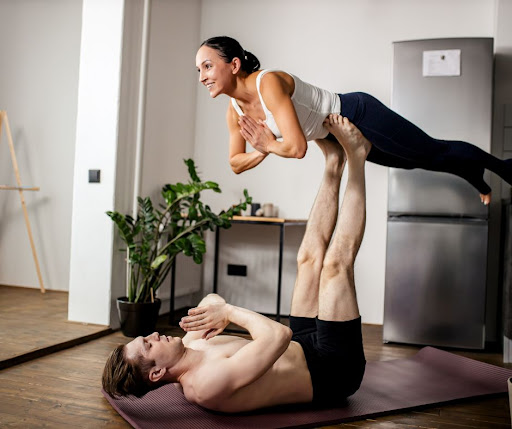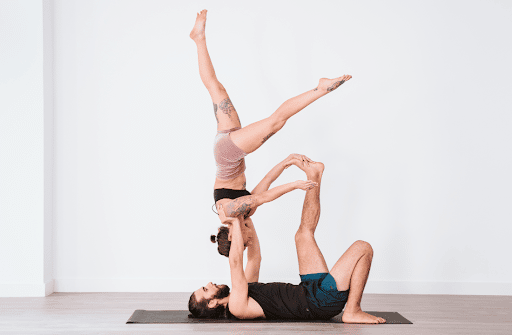Acro Yoga, a dynamic blend of yoga and acrobatics, not only tests the limits of physical strength and flexibility but also requires trust and communication between partners. While the essence of Acro Yoga lies in the synergy between individuals, having the right equipment and gear can significantly enhance the experience and ensure safety. In this comprehensive guide, we will explore the essential equipment and attire necessary for a fulfilling Acro Yoga practice.
1. Yoga Mats: The Foundation The yoga mat is fundamental in Acro Yoga. It provides a cushioned, non-slip surface which is crucial for safety and comfort, especially for the base lying on the ground.
- In Acro Yoga, the yoga mat serves not just as a personal space for practice, but as a crucial element of safety and comfort for both the base and the flyer. Here’s a more detailed look at what to consider when selecting a yoga mat for Acro Yoga:1. Thickness:
- Standard vs. Thick Mats: Standard yoga mats are typically about 1/8 inch (3 mm) thick, providing a close connection to the floor. For Acro Yoga, however, a thicker mat (around 1/4 inch or 6 mm) is often recommended. This extra padding is beneficial for the base, offering more cushioning for the spine, hips, and shoulders when supporting the flyer’s weight.
- High-Density Foam: Some mats are designed with high-density foam, which provides excellent shock absorption without being too soft. A mat that’s too soft can make balance more challenging.
2. Material:
- Eco-Friendly Options: Many practitioners prefer environmentally friendly mats made from natural rubber, jute, or organic cotton. These materials often provide superior grip and durability.
- PVC Mats: While not eco-friendly, PVC mats (polyvinyl chloride) are known for their durability and stickiness. They can be a good choice if grip and longevity are your main concerns.
3. Texture and Grip:
- Surface Texture: The texture of a yoga mat contributes significantly to its grip. Mats with a slightly raised tactile pattern tend to provide better grip, reducing the risk of slipping during dynamic Acro Yoga movements. This is especially important for poses where precise foot and hand placement are crucial.
- Stickiness: A sticky yoga mat can help you maintain alignment as you move, which is vital in Acro Yoga for both safety and pose integrity. The stickiness ensures that the mat stays firmly in place and provides a stable surface.
4. Size and Portability:
- Larger Mats: Given that Acro Yoga is a partner practice, considering a larger mat can be beneficial. Standard yoga mats are typically 24 inches wide and 68 inches long. For Acro Yoga, a wider or longer mat can provide more space and comfort, especially when practicing more expansive poses.
- Portability: If you’re attending Acro Yoga classes or workshops, a mat that’s easy to carry can be a plus. Look for mats that come with their own carrying straps or bags, or consider a lightweight design if you travel frequently with your mat.
5. Durability:
- Wear and Tear: Acro Yoga can be more demanding on a yoga mat compared to traditional yoga due to the dynamic movements and additional weight. Look for mats designed for durability, able to withstand frequent use without tearing or losing their shape.
- Warranty and Quality: Some higher-end yoga mats come with a warranty, which can be a good indicator of the mat’s quality and the manufacturer’s confidence in its durability.
6. Cleaning and Care:
- Ease of Cleaning: Regular cleaning is essential to maintain the hygiene and grip of the mat. Choose a mat that is easy to clean, either with a quick wipe down or a wash with mild soap and water.
- Maintenance Tips: Avoid exposing your yoga mat to excessive sunlight, as this can degrade certain materials over time. Also, storing the mat properly, either rolled up or laid flat, can help maintain its shape and longevity.
7. Cost Considerations:
- Price Range: The price of yoga mats can vary significantly, from budget-friendly options to premium mats. While higher-priced mats often offer better quality and durability, there are also mid-range mats that offer a good balance of quality and affordability.
- Investment in Practice: Consider your yoga mat as an investment in your Acro Yoga practice. A good-quality mat can enhance your experience, provide comfort, and last for years.
2. Practice Clothes:
When it comes to Acro Yoga, the clothing you choose plays a significant role in your overall experience. The right attire should provide comfort, allow for a full range of motion, and also be functional to accommodate the dynamic nature of Acro Yoga. Here’s a detailed look at what to consider when selecting practice clothes for Acro Yoga:
1. Fabrics:
-
- Breathable Materials: Opt for fabrics that allow your skin to breathe, such as cotton blends, bamboo, or moisture-wicking synthetic fibers. These materials help in managing sweat and keeping you cool.
- Stretchability: Given the range of movements in Acro Yoga, choose fabrics with good stretch. Look for a blend of spandex or Lycra with other materials to ensure your clothing moves with your body.
2. Tops:
-
- Fitted Shirts: Tight-fitting shirts are preferable as they stay in place during inverted poses and don’t ride up. For women, tank tops or sports bras offer good support and mobility. For men, fitted t-shirts or tank tops work well.
- Length and Coverage: Ensure your top is long enough to cover your midriff during various poses but not so long that it becomes cumbersome.
3. Bottoms:
-
- Leggings or Yoga Pants: For both men and women, leggings or fitted yoga pants are ideal. They provide the necessary stretch and coverage while allowing a full range of motion.
- Shorts: If you prefer shorts, choose ones with a fitted leg to prevent them from riding up. Some practitioners wear shorts over leggings for added comfort and coverage.
4. Footwear:
-
- Barefoot Practice: Acro Yoga is typically practiced barefoot to enhance grip, balance, and proprioceptive feedback. If footwear is necessary due to the environment, opt for yoga socks with grips.
5. Additional Considerations:
-
- Avoid Loose Clothing: Loose clothing can get tangled, caught, or shift in ways that can be distracting or even pose a safety risk during practice.
- Jewelry and Accessories: Remove jewelry, watches, and other accessories that could catch, scratch, or interfere with movement.
- Hair Management: If you have long hair, tying it up can prevent it from getting in the way during poses and transitions.
6. Seasonal Adjustments:
-
- Layering for Cooler Weather: In colder environments, layer your clothing so that you can easily adjust to changes in temperature. Start with a base layer that maintains body temperature and add a removable layer on top.
- Lightweight Options for Warm Weather: In warmer settings, lightweight and breathable fabrics are key. Choose clothing that helps wick away sweat without being too heavy or constricting.
7. Personal Style and Comfort:
-
- Style Preferences: While functionality is key, your clothing should also reflect your personal style and make you feel confident and comfortable.
- Trial and Adaptation: As you practice, pay attention to how your clothing performs. You might need to try a few options before finding the perfect fit for your Acro Yoga practice.
-
- Tops: Form-fitting tops are advisable. They should stay in place when you’re upside down.
- Bottoms: Yoga pants or leggings are ideal. Ensure they are stretchy and snug.
- Footwear: Acro Yoga is usually practiced barefoot to enhance grip and tactile feedback.
3. Props for Support and Alignment While not always necessary, certain props can be beneficial, especially for beginners.
- Yoga Blocks: Useful for improving alignment or as hand/foot supports.
- Straps: Helpful for stretches and maintaining poses.
- Bolsters or Cushions: Provide additional support and comfort, particularly for the base.
4. Safety Gear: Spotting and Padding Safety should be the foremost concern in Acro Yoga.
Safety is paramount in Acro Yoga, a practice that involves complex physical coordination and trust between partners. The right safety gear can prevent injuries and provide a secure environment for both beginners and experienced practitioners. Here’s an in-depth look at the essential safety gear for Acro Yoga:
1. Crash Mats:
-
- Importance: A must-have for any Acro Yoga practice, crash mats provide cushioning for falls and added protection during challenging poses.
- Thickness and Size: Look for mats that are thick enough to absorb impact effectively. A thickness of at least 2 inches is recommended. Larger mats offer more coverage but consider storage and portability as well.
- Material: High-density foam is ideal as it offers the right balance between softness and support. The cover should be durable and easy to clean.
2. Spotting:
-
- Role of Spotters: While not a physical piece of gear, spotters are crucial for safety in Acro Yoga. A spotter is someone who stands by to guide, assist, and protect the flyer and base during practice.
- Training: It’s important for spotters to understand their role and be trained in how to support and catch a flyer effectively to prevent injury.
3. Hand and Wrist Protection:
-
- Wrist Guards: For those with weak or previously injured wrists, wrist guards can provide additional support.
- Grip Gloves: Gloves designed for grip can help prevent slipping, which is particularly useful for bases handling flyers.
4. Knee and Elbow Pads:
-
- Padded Protection: For poses that put pressure on knees or elbows, pads can provide cushioning and prevent bruising or discomfort.
- Fit and Comfort: Ensure that these pads fit snugly and don’t restrict movement.
5. Back Supports:
-
- Support Belts: Bases may benefit from wearing back support belts, especially if they have a history of back pain.
- Correct Usage: It’s important to use these supports as a preventive measure rather than a solution to existing pain. Consult a healthcare professional for advice.
6. Headgear:
-
- Protective Headgear: In some instances, especially for beginners or during complex poses, wearing protective headgear can prevent head injuries.
- Comfort and Visibility: Choose headgear that is comfortable and does not obstruct vision or movement.
7. Environmental Safety:
-
- Indoor Practice: Ensure the practice area is clear of obstacles and has enough space for movement.
- Outdoor Practice: Be mindful of the terrain and weather conditions. Soft grass or sand can provide natural cushioning.
8. Attire as Safety Gear:
-
- Fitted Clothing: As mentioned earlier, properly fitted clothing can also serve as safety gear by preventing entanglement and ensuring better grip.
9. Hydration and First Aid:
-
- Water Bottles: Stay hydrated to prevent cramps and maintain focus.
- First Aid Kit: Always have a basic first aid kit nearby, equipped with essentials like band-aids, antiseptic wipes, and ice packs.
-
- Crash Mats: Investing in a crash mat or a thick gymnastics mat can be a wise decision, especially for practicing new or challenging poses.
- Spotters: Not equipment per se, but having a spotter – a third person who can guide and protect the flyer and base – is invaluable, especially when trying out new moves.
5. Attire for Outdoor Practice If you’re practicing outdoors, your clothing needs might slightly differ.
- Layered Clothing: Be prepared for changing weather conditions.
- Sun Protection: Consider lightweight, long-sleeved tops and sunscreen for sun protection.
6. Hydration and Nutrition Staying hydrated and nourished is crucial, especially in a physically demanding practice like Acro Yoga.
- Water Bottles: Always have a water bottle at hand.
- Snacks: Energy bars or fruits can be great for a quick energy boost.
7. Cleaning and Maintenance Keeping your equipment clean is essential, both for hygiene and longevity.
- Mat Cleaners: Use natural cleaners to keep your mat fresh and free of bacteria.
- Clothing Care: Opt for gentle, eco-friendly detergents to maintain the durability of your yoga attire.
Conclusion: The right gear in Acro Yoga not only ensures safety but also enhances the overall experience. By investing in quality mats, appropriate clothing, and necessary props, you can create a practice that is both enjoyable and safe. Remember, the core of Acro Yoga is about connection and trust – the gear is there to support this journey.



